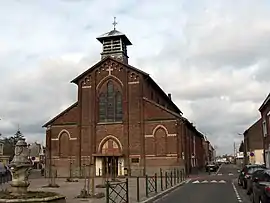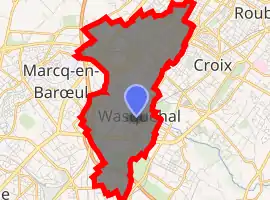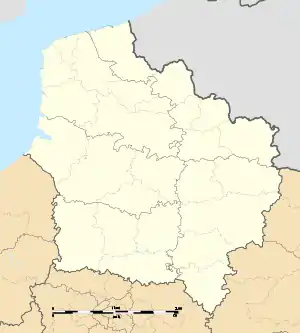Wasquehal
Wasquehal (traditional pronunciation [wakal]; currently common pronunciation [waskal]) is a commune in the Nord department in northern France.
Wasquehal | |
|---|---|
 Église Saint Clément | |
 Coat of arms | |
Location of Wasquehal 
| |
 Wasquehal  Wasquehal | |
| Coordinates: 50°40′10″N 3°07′51″E | |
| Country | France |
| Region | Hauts-de-France |
| Department | Nord |
| Arrondissement | Lille |
| Canton | Croix |
| Intercommunality | Lille |
| Government | |
| • Mayor (2020–2026) | Stéphanie Ducret[1] |
| Area 1 | 6.86 km2 (2.65 sq mi) |
| Population (2017-01-01)[2] | 20,479 |
| • Density | 3,000/km2 (7,700/sq mi) |
| Time zone | UTC+01:00 (CET) |
| • Summer (DST) | UTC+02:00 (CEST) |
| INSEE/Postal code | 59646 /59290 |
| Elevation | 18–47 m (59–154 ft) |
| 1 French Land Register data, which excludes lakes, ponds, glaciers > 1 km2 (0.386 sq mi or 247 acres) and river estuaries. | |
The town originally had a Flemish name; it was written as Waskenhal in the 11th century.
Geography
Wasquehal has an area of 6.86 km2 (2.65 sq mi) and a population density of 2,702.8/km².
Héraldique
 |
The arms of Wasquehal are blazoned : Chequy argent and gules, each argent piece charged with an ermine spot sable. or, more simply, Chequy ermine and gules. |
Population
| Year | Pop. | ±% |
|---|---|---|
| 2006 | 18,936 | — |
| 2007 | 18,989 | +0.3% |
| 2008 | 19,026 | +0.2% |
| 2009 | 19,187 | +0.8% |
| 2010 | 20,046 | +4.5% |
| 2011 | 19,998 | −0.2% |
| 2012 | 20,536 | +2.7% |
| 2013 | 20,990 | +2.2% |
| 2014 | 21,343 | +1.7% |
| 2015 | 20,963 | −1.8% |
| 2016 | 20,722 | −1.1% |
Sport
Wasquehal hosted the finish of stage 4 of the 1989 Tour de France, won by Jelle Nijdam, and the finish of stage 5 the 1992 Tour de France, won by Guido Bontempi. The third stage of the 2004 Tour de France also finished in Wasquehal. Jean-Patrick Nazon won the mass sprint ahead of Erik Zabel and Robbie McEwen. Wasquehal also hosted the start of stage 7 of the 1988 Tour de France, and the start of stage 3 of the 1996 Tour de France.
Sister city
Wasquehal is twinned with Beyne-Heusay (Belgium)
References
- "Répertoire national des élus: les maires". data.gouv.fr, Plateforme ouverte des données publiques françaises (in French). 2 December 2020. Retrieved 11 December 2020.
- "Populations légales 2017". INSEE. Retrieved 6 January 2020.
.svg.png.webp)